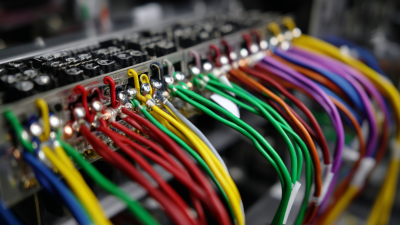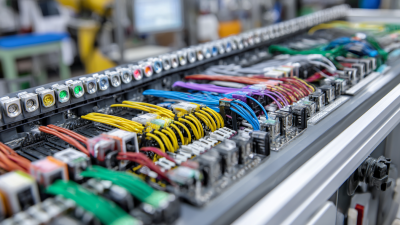The Ultimate Guide to Streamlining Your Harness Assembly Process for Maximum Efficiency
In today's competitive manufacturing landscape, optimizing the harness assembly process is paramount to achieving operational excellence and profitability. According to a report by Allied Market Research, the global wiring harness market is expected to reach $83.2 billion by 2026, with a CAGR of 5.8%. This growth is driven by the increasing demand for advanced automotive technologies and the rise of electric vehicles, which necessitate more efficient harness assembly methods. Streamlining this essential process not only reduces production times but also minimizes errors and wastage, enhancing overall quality. By implementing best practices and innovative solutions, manufacturers can significantly leverage the benefits of harness assembly to boost efficiency, satisfy customer demands, and stay ahead in this fast-evolving industry.

Benefits of Streamlined Processes in Harness Assembly
Streamlining the harness assembly process brings numerous benefits that significantly enhance overall efficiency.
One of the most immediate advantages is the reduction of production time. By optimizing workflows and eliminating unnecessary steps, manufacturers can accelerate assembly times, enabling them to meet tight deadlines and improve turnaround rates. This efficiency not only boosts productivity but also allows for better resource management, freeing up labor and materials for other critical tasks within the production line.
Additionally, streamlined processes contribute to improved quality control. When assembly procedures are standardized and clearly defined, the likelihood of errors decreases substantially. Workers can follow precise instructions with greater ease, ensuring consistent and reliable output. This not only minimizes waste and rework but also enhances the overall durability of the harnesses produced.
As a result, businesses can build a stronger reputation for quality, leading to increased customer satisfaction and retention. Ultimately, embracing streamlined processes in harness assembly not only fosters a more efficient operation but also positions companies for sustained growth in a competitive marketplace.
Enhanced Productivity Through Efficient Workflow Strategies
Streamlining workflows is essential for enhancing productivity across various industries. With recent advancements in technology, organizations are increasingly looking to AI-driven solutions to optimize their operations. A study on AI in the workplace revealed that 73% of employees believe AI can enhance their productivity by automating routine tasks, allowing them to focus on more strategic initiatives. Companies are not only adopting AI but also integrating sophisticated workflow automation tools that serve to improve efficiency and reduce operational costs.
A compelling example of this trend is the introduction of simplified workflow management tools that assist researchers in organizing data pipelines effectively. For instance, a new Python library aimed at facilitating research productivity demonstrates that enhanced accessibility and ease of use can significantly reduce the time spent on project management. Furthermore, the market for workflow automation is projected to grow at a CAGR of 25% through 2025, indicating a robust willingness among businesses to invest in strategies that bolster efficiency. Embracing these advancements enables organizations to refine their workflows, which ultimately enhances their productivity and operational performance.
Cost Savings: How Optimization Reduces Waste and Errors
In today's fast-paced manufacturing environment, optimizing the harness assembly process is crucial for cost savings and operational efficiency. By streamlining workflows and implementing best practices, businesses can significantly reduce waste and minimize errors that lead to rework. One effective approach is to analyze each step of the assembly process, identifying bottlenecks and areas for improvement. For instance, by employing standardized procedures and utilizing automation, companies can enhance accuracy and speed, ensuring that every component is assembled correctly the first time.

Moreover, investing in employee training and engagement is essential to maintaining a high-quality assembly line. When workers are well-trained and informed about the most efficient practices, they are less likely to make mistakes. This not only leads to fewer defects but also fosters a culture of continuous improvement. By encouraging employees to provide feedback and share insights on the assembly process, organizations can uncover hidden inefficiencies and implement actionable changes that drive further optimization.
Ultimately, focusing on these strategies can yield significant cost savings and establish a more productive harness assembly operation.
Improved Quality Control Measures in Harness Assembly
In today’s competitive manufacturing landscape, ensuring high-quality control measures in harness assembly is crucial for both efficiency and reliability. Implementing a systematic approach involves detailed inspections at various stages of the assembly process. By introducing automated quality checks, manufacturers can reduce human error, ensuring that each component meets the stipulated standards before moving on to the next phase of assembly. This step not only sharpens the focus on quality but also significantly cuts down on rework time and associated costs.
Moreover, cultivating a culture of continuous improvement is essential for effective quality control. Training employees to identify potential issues during assembly fosters a proactive environment. Regular feedback loops and performance evaluations can help refine processes, allowing teams to adapt to new challenges. Additionally, utilizing key performance indicators (KPIs) related to quality can provide valuable insights into the efficacy of current practices, enabling teams to pinpoint areas requiring attention.
Through these improved quality control measures, organizations can streamline their harness assembly processes, enhancing overall productivity while minimizing defects and maximizing customer satisfaction.
The Role of Technology in Maximizing Assembly Efficiency
In today's fast-paced manufacturing landscape, the integration of technology in the harness assembly process is essential for maximizing efficiency. Advances in precision manufacturing techniques, coupled with effective supply chain management, allow companies to streamline their operations significantly. By leveraging automated systems and sophisticated software, manufacturers can enhance the accuracy and speed of their assembly lines. This not only reduces production costs but also minimizes errors, ultimately leading to better product quality.

Moreover, the experience gained in one sector can significantly benefit another. For instance, expertise in electronic contract manufacturing has proven invaluable for various industries, particularly in the automotive sector. By applying advanced manufacturing technologies from the electronics field, companies can improve the assembly efficiency of their automotive products. The interplay between different sectors illustrates the importance of technological innovation, showcasing how effective techniques in one area can drive improvements and efficiencies in others, reinforcing the need for a holistic approach to manufacturing processes.
Related Posts
-

The Definitive Ultimate Guide to Mastering Wire Harness Assembly for Optimal Performance
-

Essential Harness Assembly Checklist for Streamlined Production Efficiency
-

Challenges Faced in Cable Harness Design Efficiency
-

Innovative Applications of Molded Cable Assemblies Across Various Industries
-

Explore Superior Wire Harness Assembly Solutions from Leading Chinese Manufacturers